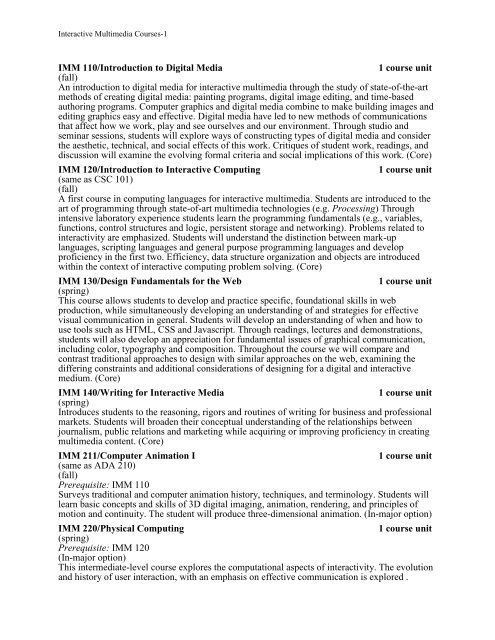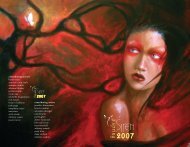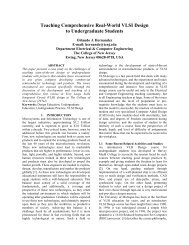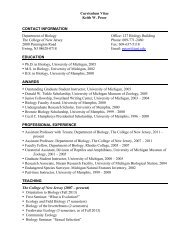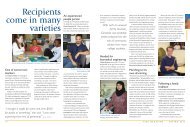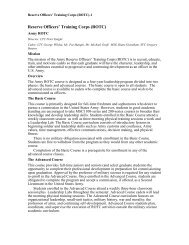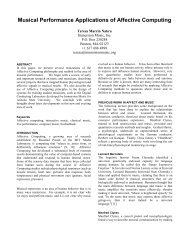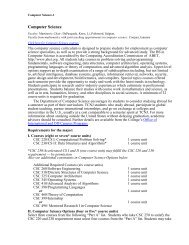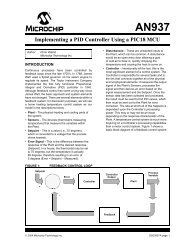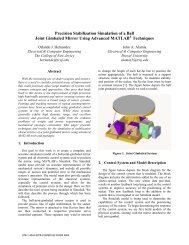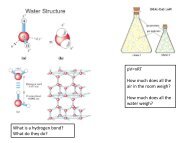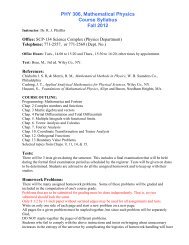IMM 110/Introduction to Digital Media 1 course unit (fall) An ...
IMM 110/Introduction to Digital Media 1 course unit (fall) An ...
IMM 110/Introduction to Digital Media 1 course unit (fall) An ...
You also want an ePaper? Increase the reach of your titles
YUMPU automatically turns print PDFs into web optimized ePapers that Google loves.
Interactive Multimedia Courses-1<br />
<strong>IMM</strong> <strong>110</strong>/<strong>Introduction</strong> <strong>to</strong> <strong>Digital</strong> <strong>Media</strong><br />
1 <strong>course</strong> <strong>unit</strong><br />
(<strong>fall</strong>)<br />
<strong>An</strong> introduction <strong>to</strong> digital media for interactive multimedia through the study of state-of-the-art<br />
methods of creating digital media: painting programs, digital image editing, and time-based<br />
authoring programs. Computer graphics and digital media combine <strong>to</strong> make building images and<br />
editing graphics easy and effective. <strong>Digital</strong> media have led <strong>to</strong> new methods of communications<br />
that affect how we work, play and see ourselves and our environment. Through studio and<br />
seminar sessions, students will explore ways of constructing types of digital media and consider<br />
the aesthetic, technical, and social effects of this work. Critiques of student work, readings, and<br />
discussion will examine the evolving formal criteria and social implications of this work. (Core)<br />
<strong>IMM</strong> 120/<strong>Introduction</strong> <strong>to</strong> Interactive Computing<br />
1 <strong>course</strong> <strong>unit</strong><br />
(same as CSC 101)<br />
(<strong>fall</strong>)<br />
A first <strong>course</strong> in computing languages for interactive multimedia. Students are introduced <strong>to</strong> the<br />
art of programming through state-of-art multimedia technologies (e.g. Processing) Through<br />
intensive labora<strong>to</strong>ry experience students learn the programming fundamentals (e.g., variables,<br />
functions, control structures and logic, persistent s<strong>to</strong>rage and networking). Problems related <strong>to</strong><br />
interactivity are emphasized. Students will understand the distinction between mark-up<br />
languages, scripting languages and general purpose programming languages and develop<br />
proficiency in the first two. Efficiency, data structure organization and objects are introduced<br />
within the context of interactive computing problem solving. (Core)<br />
<strong>IMM</strong> 130/Design Fundamentals for the Web<br />
1 <strong>course</strong> <strong>unit</strong><br />
(spring)<br />
This <strong>course</strong> allows students <strong>to</strong> develop and practice specific, foundational skills in web<br />
production, while simultaneously developing an understanding of and strategies for effective<br />
visual communication in general. Students will develop an understanding of when and how <strong>to</strong><br />
use <strong>to</strong>ols such as HTML, CSS and Javascript. Through readings, lectures and demonstrations,<br />
students will also develop an appreciation for fundamental issues of graphical communication,<br />
including color, typography and composition. Throughout the <strong>course</strong> we will compare and<br />
contrast traditional approaches <strong>to</strong> design with similar approaches on the web, examining the<br />
differing constraints and additional considerations of designing for a digital and interactive<br />
medium. (Core)<br />
<strong>IMM</strong> 140/Writing for Interactive <strong>Media</strong><br />
1 <strong>course</strong> <strong>unit</strong><br />
(spring)<br />
Introduces students <strong>to</strong> the reasoning, rigors and routines of writing for business and professional<br />
markets. Students will broaden their conceptual understanding of the relationships between<br />
journalism, public relations and marketing while acquiring or improving proficiency in creating<br />
multimedia content. (Core)<br />
<strong>IMM</strong> 211/Computer <strong>An</strong>imation I<br />
1 <strong>course</strong> <strong>unit</strong><br />
(same as ADA 210)<br />
(<strong>fall</strong>)<br />
Prerequisite: <strong>IMM</strong> <strong>110</strong><br />
Surveys traditional and computer animation his<strong>to</strong>ry, techniques, and terminology. Students will<br />
learn basic concepts and skills of 3D digital imaging, animation, rendering, and principles of<br />
motion and continuity. The student will produce three-dimensional animation. (In-major option)<br />
<strong>IMM</strong> 220/Physical Computing<br />
1 <strong>course</strong> <strong>unit</strong><br />
(spring)<br />
Prerequisite: <strong>IMM</strong> 120<br />
(In-major option)<br />
This intermediate-level <strong>course</strong> explores the computational aspects of interactivity. The evolution<br />
and his<strong>to</strong>ry of user interaction, with an emphasis on effective communication is explored .
Interactive Multimedia Courses-2<br />
Topics include but are not limited <strong>to</strong>: simple question/answering; teletype, and text-based<br />
computer communication; dialog and turn taking; cursor driven menus; graphical user interfaces<br />
and events; hypermedia; integration of multimedia and streaming. Modern techniques will be<br />
mastered using HTML, javascript, and Flash providing students with practical skills <strong>to</strong> support<br />
the conceptual framework of the <strong>course</strong>. Projects will require students <strong>to</strong> apply design skills <strong>to</strong><br />
integrate textual and graphical media in order <strong>to</strong> achieve a range of communicative goals. ((Inmajor<br />
option)<br />
<strong>IMM</strong> 230/Dynamic Web Applications<br />
1 <strong>course</strong> <strong>unit</strong><br />
(<strong>fall</strong>)<br />
Prerequisite: <strong>IMM</strong> 130<br />
This <strong>course</strong> provides students with advanced web development skills and strategies <strong>to</strong> build<br />
dynamic web applications. Students will develop an understanding of how <strong>to</strong> use server-side<br />
technologies such as PHP and MySQL <strong>to</strong> collect, organize and distribute information. In<br />
addition, students will utilize client-side frameworks such as jQuery Mobile and PhoneGap <strong>to</strong><br />
assist in the delivery of data-driven applications on mobile devices. Through workshops and<br />
presentations, students will explore <strong>to</strong>pics related <strong>to</strong> information architecture, social interface<br />
design, cloud computing, security, copyright and identity management. (In-major option)<br />
<strong>IMM</strong> 240/Technical Writing<br />
1 <strong>course</strong> <strong>unit</strong><br />
(occasionally)<br />
Prerequisite: <strong>IMM</strong> 140<br />
This <strong>course</strong> teaches students the writing, scripting and document design skills needed <strong>to</strong> create<br />
training materials, technical reports, and technical or business proposals in print, online or<br />
interactive formats. (In-major option)<br />
<strong>IMM</strong> 250/ Electronic Music Skills and Literature<br />
1 <strong>course</strong> <strong>unit</strong><br />
(same as ADA 345 and MUS 345)<br />
(every semester)<br />
Prerequisite: <strong>IMM</strong> <strong>110</strong><br />
This <strong>course</strong> introduces students <strong>to</strong> electronic music studio techniques, including MIDI,<br />
sequencing, sound synthesis, sampling, mixing, and audio production. It also covers theoretical<br />
and his<strong>to</strong>rical developments in the field of electronic music, including a review of compositions,<br />
styles, and technologies. Students create their own musical compositions in the computer lab.<br />
Open <strong>to</strong> students of any major. (In-major option)<br />
<strong>IMM</strong> 270/ Topics in Interactive Multimedia<br />
1 <strong>course</strong> <strong>unit</strong><br />
(Occasionally)<br />
Focuses on current or specialized <strong>to</strong>pics in interactive multimedia. May be repeated for different<br />
<strong>to</strong>pics. (In-major option)<br />
<strong>IMM</strong> 280/Design Perspectives in Interactive Multimedia<br />
1 <strong>course</strong> <strong>unit</strong><br />
(spring)<br />
Prerequisites: <strong>IMM</strong> <strong>110</strong>, 120, 130, 140<br />
This class is interdisciplinary, bringing <strong>to</strong>gether the various bodies of knowledge that inform the<br />
field of interactive multimedia, such as s<strong>to</strong>rytelling, interaction design, interface design, project<br />
management and user testing. The class provides an overview of concepts necessary both <strong>to</strong><br />
create and evaluate interactive multimedia projects. Students apply these ideas <strong>to</strong> a series of<br />
individual writing and production assignments, and ultimately <strong>to</strong> a collaborative project that<br />
spans most of the semester. This writing-intensive <strong>course</strong> is the last of the five core <strong>course</strong>s for<br />
the Interactive Multimedia major, and is a prerequisite for all 300-level and above <strong>course</strong>s.<br />
(Core)<br />
<strong>IMM</strong> 311/Computer <strong>An</strong>imation II<br />
Same as ADA 310<br />
(spring)<br />
Prerequisites: <strong>IMM</strong> 211 and <strong>IMM</strong> 280<br />
1 <strong>course</strong> <strong>unit</strong>
Interactive Multimedia Courses-3<br />
This <strong>course</strong> builds on the foundation in 3D computer animation begun in <strong>IMM</strong>210. It develops<br />
the student's basic animation skills with additional emphasis on 3D object creation and animation<br />
techniques (model building, rendering, animating). Creative and conceptual development are<br />
emphasized throughout the <strong>course</strong> and students will develop individual or group animation<br />
projects. (In-major option)<br />
<strong>IMM</strong> 320/Information Retrieval<br />
1 <strong>course</strong> <strong>unit</strong><br />
(same as CSC 320)<br />
(occasionally)<br />
Prerequisites: CSC 230 or CSC 250 or <strong>IMM</strong> 280<br />
This <strong>course</strong> will discuss theory and practice of searching and retrieval of text and bibliographic<br />
information. Topics covered include au<strong>to</strong>mated indexing, statistical and linguistic models, text<br />
classification, Boolean and probabilistic approaches <strong>to</strong> indexing, query formulation and output<br />
ranking, information routing and filtering, <strong>to</strong>pic detection and tracking, as well as measures of<br />
retrieval effectiveness, including relevance, utility, miss/false-alarm. Techniques for enhancing<br />
retrieval effectiveness including relevance feedback, query reformulation, thesauri, concept<br />
extraction, and au<strong>to</strong>mated summarization. Experimental retrieval approaches from relevant stateof-the-art<br />
conferences as well as modern Internet search engines are discussed in detail. (Inmajor<br />
option)<br />
<strong>IMM</strong> 342/Interactive S<strong>to</strong>rytelling<br />
1 <strong>course</strong> <strong>unit</strong><br />
(occasionally)<br />
Prerequisites: <strong>IMM</strong> 280<br />
This <strong>course</strong> will explore existing and experimental methods for telling interactive s<strong>to</strong>ries.<br />
Interactive s<strong>to</strong>ries are defined as s<strong>to</strong>ries that allow the audience, listener, or reader <strong>to</strong> participate<br />
in the shaping of the narrative. Students will be able <strong>to</strong> articulate the differences between linear,<br />
non- linear, multilinear and meta-linear narratives. Students will analyze s<strong>to</strong>ries, they will create<br />
their own interactive s<strong>to</strong>ries using multimedia technologies, and they will hypothesize about the<br />
potential usefulness and social utility of new s<strong>to</strong>rytelling technologies under development. (Inmajor<br />
option)<br />
<strong>IMM</strong> 350/Interactive Music Programming<br />
1 <strong>course</strong> <strong>unit</strong><br />
(same as MUS 336)<br />
(spring)<br />
Prerequisites: <strong>IMM</strong> 250 and <strong>IMM</strong> 280<br />
This <strong>course</strong> will help students develop interactive music programming skills using the Macin<strong>to</strong>sh<br />
operating system (OSX). We will use the MAX/MSP development environment <strong>to</strong> send and<br />
receive MIDI messages and process audio streams in real-time. External controllers and sensors<br />
will be used <strong>to</strong> shape and perform musical selections. Final projects will demonstrate both<br />
technical and musical skills in composition, interactivity, and/or improvisation. (In-major option)<br />
<strong>IMM</strong> 351/Studio Composition and Signal Processing<br />
1 <strong>course</strong> <strong>unit</strong><br />
Same as MUS 335<br />
(<strong>fall</strong>)<br />
Prerequisites: <strong>IMM</strong> 250 and <strong>IMM</strong> 280<br />
Students will learn how <strong>to</strong> use audio production software on the Macin<strong>to</strong>sh platform, through<br />
musical tasks such as score notation, orchestration, and composing. They will also develop<br />
quantitative skills in digital signal processing, through technical tasks such as analyzing,<br />
filtering, and synthesizing audio data. Software packages include Pd, Finale, Logic, and<br />
Audacity. (In-major option)
Interactive Multimedia Courses-4<br />
<strong>IMM</strong> 360/ Games I: Design and Architecture<br />
1 <strong>course</strong> <strong>unit</strong><br />
Same as CSC 365<br />
(<strong>fall</strong>)<br />
Prerequisite: <strong>IMM</strong> 280<br />
This is a multidisciplinary <strong>course</strong> that invites students from a variety of disciplines <strong>to</strong> participate<br />
in the development of a game design while learning about the underlying architecture of a game<br />
engine. Students will cus<strong>to</strong>mize a broad set of learning goals <strong>to</strong> their own needs, ranging from<br />
the purely artistic <strong>to</strong> the purely technical. Lecture and workshops will provide a full range of<br />
exposure <strong>to</strong> game development including game engine design, s<strong>to</strong>ry telling, interactivity,<br />
networking for multi-user, 3-D pipeline for games, sound, music and dialog. Each semester will<br />
focus on a particular type of game, including but not limited <strong>to</strong> 'role playing,' first person<br />
shooter,' 'immersive learning, 'real world simulation.' Students will also address issues of gender<br />
and racial equity in the games industry as well as social, ethical and health concerns. (In-major<br />
option)<br />
<strong>IMM</strong> 370/Topics in Interactive Multimedia<br />
1 <strong>course</strong> <strong>unit</strong><br />
(occasionally)<br />
Prerequisite: <strong>IMM</strong> 280<br />
Focuses on current or specialized <strong>to</strong>pics in interactive multimedia. May be repeated for different<br />
<strong>to</strong>pics.(In-major option)<br />
<strong>IMM</strong> 386/Video Art I: Single Channel<br />
1 <strong>course</strong> <strong>unit</strong><br />
(same as ADA 386)<br />
(occasionally)<br />
Prerequisites: <strong>IMM</strong> 280 and permission of coordina<strong>to</strong>r<br />
Video Art I builds on time-based knowledge and skills learned in ADA 285/<strong>Digital</strong> Arts: Time-<br />
Based. It advances student's technical and conceptual understanding of video with an emphasis<br />
on editing and building a personal vocabulary. Students will focus on production skills (using<br />
different sound sources, lighting, and advanced framing) and post-production skills (codex,<br />
complex editing, and compositing) while further developing a conceptual approach <strong>to</strong> this<br />
medium. This <strong>course</strong> will look at the digital medium of the QuickTime movie as a turning point<br />
of video/film in an art context; works by innova<strong>to</strong>rs in the field of single-channel video artists are<br />
studied. Required reading and writing assignments will investigate video art his<strong>to</strong>ry and current<br />
theories and practices with the medium. The <strong>course</strong> will be taught by demonstration, lecture,<br />
presentations, and critiques. (In-major option).<br />
<strong>IMM</strong> 387/ Video Art II: Install/Perform<br />
1 <strong>course</strong> <strong>unit</strong><br />
(same as ADA 387<br />
(occasionally)<br />
Prerequisites: <strong>IMM</strong> 386 and permission of coordina<strong>to</strong>r<br />
<strong>An</strong> exploration of the advanced aesthetic, conceptual, and technical aspects of digital video in<br />
relation <strong>to</strong> performance and installation art. This <strong>course</strong> focuses on themes such as gesture,<br />
movement, space, and body; site-specific work; architecture and definitions of space; uses of<br />
light and material; and the formation of an event or situation. Gallery and museum field trips, as<br />
well as attendance at artist lectures, required. (In-major option)<br />
<strong>IMM</strong> 388/Web Design II: Dynamic Web Design<br />
1 <strong>course</strong> <strong>unit</strong><br />
(same as ADA 388<br />
(occasionally)<br />
Prerequisites: <strong>IMM</strong> 280<br />
This <strong>course</strong> focuses on creating dynamic or database-driven websites and the production of<br />
streaming media, extending the student's technical and creative skills beyond design <strong>to</strong> the<br />
construction of web applications. Students learn <strong>to</strong> integrate front-end design with multimedia<br />
content and dynamic data. The <strong>course</strong> includes instruction in a diverse set of scripting languages<br />
and applications. The <strong>course</strong> is oriented <strong>to</strong>ward technical students with creative aspirations as the<br />
use of the internet as an expressive social medium is explored. (In-major option)
Interactive Multimedia Courses-5<br />
<strong>IMM</strong> 391/Independent Study in Interactive Multimedia variable <strong>course</strong> <strong>unit</strong>s<br />
every semester)<br />
Prerequisites: <strong>IMM</strong> 280 and permission of coordina<strong>to</strong>r<br />
Individual, in-depth study of an area in interactive multimedia developed in consultation with a<br />
faculty men<strong>to</strong>r. May be repeated for different <strong>to</strong>pics. (In-major option)<br />
<strong>IMM</strong> 399/Internship in <strong>Media</strong><br />
variable <strong>course</strong> <strong>unit</strong>s<br />
(every semester)<br />
Prerequisites: <strong>IMM</strong> 280 and permission of coordina<strong>to</strong>r<br />
<strong>An</strong> opport<strong>unit</strong>y <strong>to</strong> work with interactive multimedia professionals in consultation with a faculty<br />
men<strong>to</strong>r. (In-major option)<br />
<strong>IMM</strong> 410/Time <strong>Media</strong>: Video Effects and Compositing<br />
1 <strong>course</strong> <strong>unit</strong><br />
(occasionally)<br />
Prerequisites: <strong>IMM</strong> 211 and <strong>IMM</strong> 280<br />
<strong>An</strong> advanced <strong>course</strong> in digital media that combines 2D and 3D still and motion image creation<br />
with video editing, compositing, and sound in order <strong>to</strong> produce dynamic media. It explores the<br />
way that images, sound, and narrative elements combine <strong>to</strong> produce significant and meaningful<br />
visual effects extending through time. The class looks at the his<strong>to</strong>ry, aesthetics, and current<br />
practice of time-based media. Students will design, produce, and present advanced media<br />
projects based on appropriate computer and digital media technologies. Students will use highend<br />
desk<strong>to</strong>p software integrating digital paint, tracking, masking, keying, particles with 2D and<br />
3D composition and special effects. Students will cover the structure, interface, workflow, and<br />
techniques used <strong>to</strong> create sophisticated and complex shots, scenes, and graphic sequences. (Inmajor<br />
option)<br />
<strong>IMM</strong> 443/Computer-Assisted Reporting<br />
1 <strong>course</strong> <strong>unit</strong><br />
(same as JPW 301)<br />
(annually)<br />
Prerequisites: <strong>IMM</strong> 280<br />
The <strong>course</strong> teaches basic skills associated with investigative reporting. Students will learn <strong>to</strong><br />
mine and interpret official data, <strong>to</strong> use technology commonly employed in computer-assisted<br />
reporting, and <strong>to</strong> formulate and test a journalistic research hypothesis. Particular attention will be<br />
given <strong>to</strong> issues of ethics, privacy and freedom of information. (In-major option)<br />
<strong>IMM</strong> 460/ Games II: Implementation and Project Management<br />
1 <strong>course</strong> <strong>unit</strong><br />
(same as CSC 465)<br />
(spring)<br />
Prerequisites: <strong>IMM</strong> 360 or permission of coordina<strong>to</strong>r<br />
This is a multidisciplinary <strong>course</strong> that invites students from a variety of disciplines <strong>to</strong> participate<br />
in the implementation of a robust demonstration video game. Programmers, software engineers,<br />
digital artists , sound specialists and musicians work collaboratively <strong>to</strong> create a single game<br />
(designed in Games I). Each student defines a personal role in the process so that no two students<br />
will complete the same set of <strong>course</strong> requirements. All students, however, participate in learning<br />
about and implementing a project management structure <strong>to</strong> plan and execute the sequence of<br />
activities that must take place <strong>to</strong> complete the game. Each semester will focus on a particular<br />
type of game, including but not limited <strong>to</strong> ‘role playing’, ‘first person shooter’, ‘immersive<br />
learning’, ‘real world simulation’. Students will also address issues of gender and racial equity in<br />
the games industry as well as social, ethical and health concerns. (In-major option)<br />
<strong>IMM</strong> 498/ Senior Thesis: Research and Innovation<br />
1 <strong>course</strong> <strong>unit</strong><br />
(<strong>fall</strong>)<br />
Prerequisites: Senior standing and <strong>IMM</strong> 280<br />
The first of two <strong>course</strong>s in the <strong>IMM</strong> thesis sequence, <strong>to</strong> be followed by <strong>IMM</strong> 498. This <strong>course</strong><br />
requires students <strong>to</strong> conduct rigorous research in<strong>to</strong> an area of interest within Interactive<br />
Multimedia, and <strong>to</strong> devise a project that demonstrates that research. Students implement a series
Interactive Multimedia Courses-6<br />
of proofs-of-concept and ultimately write a thorough proposal for the project they will execute in<br />
the second semester of the <strong>IMM</strong> sequence, <strong>IMM</strong> 499. (Caps<strong>to</strong>ne)<br />
Prerequisite: <strong>IMM</strong> 380<br />
<strong>IMM</strong> 499/ Senior Thesis: Process and Promotion<br />
1 <strong>course</strong> <strong>unit</strong><br />
(spring)<br />
Prerequisite: <strong>IMM</strong> 498<br />
The second of two <strong>course</strong>s in the <strong>IMM</strong> thesis sequence, preceded by <strong>IMM</strong> 498 In this caps<strong>to</strong>ne<br />
<strong>course</strong>, students work closely with faculty <strong>to</strong> implement, test and refine the project they devised<br />
in the earlier semester. This <strong>course</strong> is writing-intensive, requiring students <strong>to</strong> extensively<br />
document their research, their process and their results. (Caps<strong>to</strong>ne)


